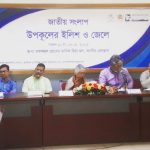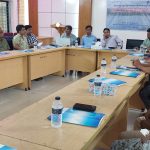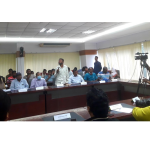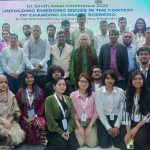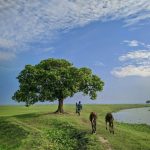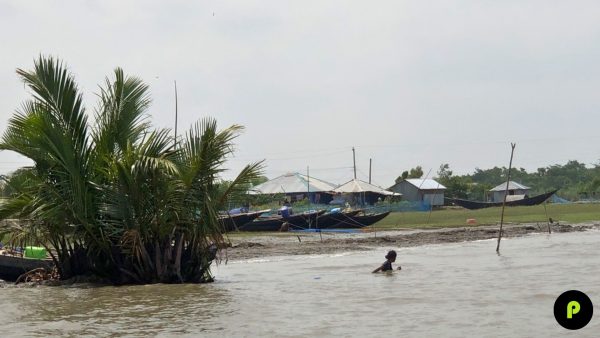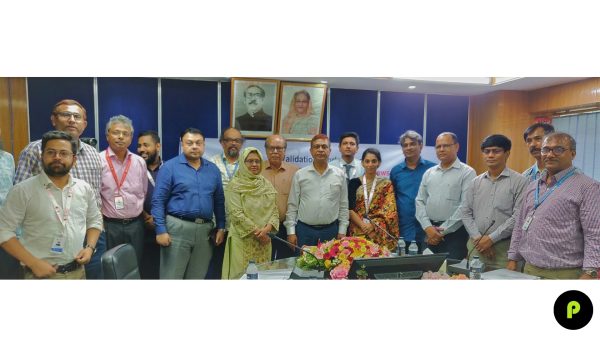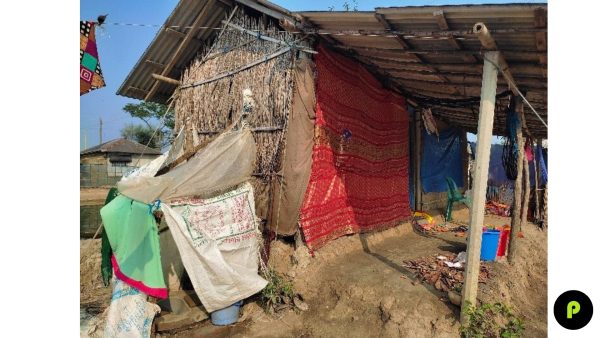“‘A lot of girls are involved in fishing for minnows. Anemia, irregular period, extreme period cramps, nausea during periods, and vomiting are too common among them. Sometimes they suffer from periods for 2-3 months at a stretch to get rid of it they take birth control pills. The family cannot afford doctors, so they also take medicine without a prescription from the local pharmacy to halt it. Continuous period leads to anemia. Again, some have claimed that they do not get adequate and nutritious food due to financial insolvency, and their food has been contaminated by saline water as well which causes anemia and may halt women’s regular periods.” 45 years old Monjo Rani, mother of two sons came to the community clinic of Banishanta Union in Dacope Upazila. This is the 3rd time in this month she is suffering from diarrhea. She is not the only patient visiting the community clinic. Multipurpose Health Volunteers Tanusree and Etika of the community health clinic of Baniashanta Union informed us, the patient burden is increasing day by day and their medicine support exceeds capacity. Every day a lot of locals come to the clinic with problems like diarrhea, allergy, gastric, and hypertension. The number of patients is increasing with time. According to the IPCC’s Fifth Assessment Report, the average global sea level rise by the end of the 21st century would be between 0.44 and 0.74 meters (m) (Church and Gregory, 2019). Even IPCC’s assessment report of the working group (iii) has mentioned the constant rise of sea level. Moreover, they recorded higher sea level rise in Asian coasts than global mean sea level rise. Bangladesh is one of them which has the most exposed coastal populations and is thus most susceptible to disaster-related death (IPCC, 2022). In recent years, frequent extreme, and severe cyclones along with storm surges have reshaped the region and caused saline water to spill into the streams, soil, and yield all around the low-lying people of the southwest coastal zone. Consumption of extremely saline water leads to diarrhea, hypertension, allergy, gastric, and even unbearable pain in the reproductive health of women. As a result, due to lack of supplies and increasing numbers of patients community clinics are running out of medicines and people like Monjo Rani are suffering. Monjo Rani is not just a victim of Diarrhea, she is also suffering from a hysterectomy since she was around 26 years old. To support her family, she had to go to work on the sixth day of each week. She stated that “My husband and mother-in-law did not give me food to eat. They had asked me to earn my bread.” She was forced to go to catch minnows. There she had to stay in the salt water for the whole day to catch minnows. This results in an infection in her uterus. Monjo Rani utter that she needs to spend a huge amount of money, so she decided to remove her uterus. She also added that she is not alone, many other women and adolescents are suffering from such uterus problems for a long time. Though they are suffering but don’t have access to medical facilities. She also said that they don’t have nearby hospitals and they need to travel more than 1.5 hours for treatment. Even a huge number of mothers and their unborn children lose their life because of inadequate health facilities, roads, and transport systems.” Monjo Rani utter that she needs to spend a huge amount of money, so she decided to remove her uterus. She also added that she is not alone, many other women and adolescents are suffering from such uterus problems for a long time. Teenage girls also have to contribute to family earnings. Girls get married early because of their poor financial background. Mim is an 18-year-old girl who came with pre-eclampsia. Her father lost their house due to cyclone Amphan. On the other hand, he does not have an income source, so he has chosen to marry off his girl. A lot of girls are involved in fishing for minnows. Anemia, irregular period, extreme period cramps, nausea during periods, and vomiting are too common among them. Sometimes they suffer from periods for 2-3 months at a stretch to get rid of it they take birth control pills. The family cannot afford doctors, so they also take medicine without a prescription from the local pharmacy to halt it. Continuous period leads to anemia. Again, some have claimed that they do not get adequate and nutritious food due to financial insolvency, and their food has been contaminated by saline water as well which causes anemia and may halt women’s regular periods. WHO has stated that the greatest threat to human health in the twenty-first century is climate change (WHO, 2021). Women are especially vulnerable to problems with their reproductive and sexual health as well as rising incidence of domestic and sexual violence, in addition to the general effects of natural hazards and a lack of disaster-resilient health care. Again, due to gender stereotypes, women are expected to take care of people affected by catastrophes, including children, the ill and injured, and the elderly, which adds to their mental and material burden. Here, all women are too strong to fight but not too healthy to live.
Bangladesh has laudable success in disaster risk reduction and climate change adaptation
“Bangladesh is a role model in climate change adaptation and disaster risk reduction globally but there are few gaps in policy and implementation”-Experts say in a policy workshop. As Bangladesh continues to experience the catastrophic consequences of climate change, it is becoming increasingly apparent that some groups are more vulnerable than others. In adapting to and coping with the effects of climate change, persons with disabilities and women often face additional difficulties. Given that the WHO estimates that approximately 17 million Bangladeshi citizens are disabled and that gender discrimination is widespread, this issue has become a matter of critical importance. As extreme weather events such as cyclones, floods, and droughts become more frequent and intense, the needs and rights of these vulnerable groups must be incorporated into the nation’s adaptation strategies for climate change. Center for People and Environ (CPE) with the support of the Center for Disability in Development (CDD) conducted a policy review study to identify gaps in policy and practice levels through the lens of gender and disability inclusion. A validation workshop was organized by CPE and CDD in the conference room of the Department of Disaster Management (DDM). In the workshop, Mr. Mijanur Rahman, Director General of DDM was present as Chief Guest. Muhammad Abdur Rahaman, Director of, the Center for People and Environ (CPE) Muhammad Abdur Rahaman, Director of, the Center for People and Environ (CPE) and Team Leader of the study presented the study findings in the study. Mr. Rahaman said Bangladesh is a role model all over the world in terms of climate change adaptation and disaster risk reduction but through the lens of disability and gender-inclusion, we have to work more. In his presentation, Mr. Rahaman said that in Bangladesh, disability statistics are not perfect. Though BBS and National Survey on Persons with Disabilities ( NSPD) generate disability statistics by government initiative there are disparities in statistics. He also said that we have enacted several policies, and acts on climate change and disaster risk reduction, but in terms of disability and gender inclusion, we have some gaps in policy and practice levels. In Cyclone Shelter Construction, Maintenance, and Management Policy 2011, there is no participation of women and gender which is a major barrier to gender and disability inclusion, he said. He also added that in the National Adaptation Plan of Bangladesh (2023-2050), through eight cross-cutting sectors (water resources; disaster, social safety, and security; agriculture; fisheries, aquaculture, and livestock; urban areas; ecosystems, wetlands, and biodiversity; policies and institutions; and capacity development, research, and innovation) are prioritized with gender and persons with disability inclusion, the plan missed women and persons with disability-inclusive health adaptation (accessible disaster-resilient health infrastructure, health workforce, etc. Though reproductive health is one of the major issues yet in policies, this crucial issue is not prioritized. Md. Mijanur Rahman, DG, DDM, stated that “Disabled people are non-other than our own family, they are our brothers and sisters. So, we cannot but have to integrate and develop disable friendly infrastructures”. He also added that Public Private Partnership (PPP) is necessary for effective preparedness for disasters. “Disaster is not a single government work. Everybody should be aware of the disasters and proper safety training for persons with disability (PWD) and their families should be arranged. A holistic approach should be integrated into all sectors, public and private, which will reduce the obstacle for the person with disabilities”. Syed Ashraf, CMS, DDM mentioned that “Some of the cyclone shelters have developed the accessibility for the person with disability people but now it is necessary to develop or redesign all cyclone shelters with universal infrastructure for the person with multiple disabilities.” M.A. Halim, the Director, of BDRCS, mentioned the database regarding persons with disability, the national database covers the number of people with disability, but it does not cover the type of disabilities and its quantitative segregations, which is majorly required for all the pillars starting from planning to response and recovery. The session discussed several aspects of climate change inclusion of disability and gender with several pros and cons along with their gaps, following the path of this discussion several policies and acts brought forth, Bangladesh Climate Change Strategy and Action Plan (BCCSAP) 2009, Cyclone Shelter Construction Management and Maintenance Act 2011, National Survey on Persons with Disabilities (NSPD) 2019, Standing Orders on Disaster (SOD) 2019, Mujib Climate Prosperity Plan Decade 2030, National Adaptation Plan (NAP) and others. The discussion also praised the latest Eight Five Year Plan (8FYP) 2021-2025, which addressed a lot of the previous gaps. Netai Chandra Dey Sarker, Director (MIM), DDM, mentioned that a lot of policies, laws, and acts were taken, but mentioned their proper implementation. “We should focus on that we have already ought to take several aspects in inclusion, but we have yet to complete the statements made with proper implementation”. The workshop concluded with a message emphasizing the significance of awareness and preparedness to enhance resilience against the effects of climate change-induced disasters. The efforts of CPE, CDD, and other organizations to raise awareness and address the gaps are essential for the development of a sustainable and inclusive future for climate change inclusion with disabilities and gender equality in Bangladesh. The primary objective of the workshop is to emphasize the significance of Gender and Disability inclusion. Md. Abdullah Al-Mamun, (Joint Secretary), Director (Admin), DDM; A.H.M. Noman Khan, Executive Director, CDD; Nazmul Bari, Director, CDD; Syed Ashraf, CMS, DDM, and some renowned experts also provided their opinion in the workshop.
Climate Change Exacerbates Human Trafficking in Bangladesh’s Southern Coastal Belt
Muhammad Abdur Rahaman, Zereen Saba, Masrur Abdul Quader The southern coast of Bangladesh is renowned for its breathtaking natural scenery, diverse wildlife, and thriving fishing communities. However, it is also one of the world’s most climate-vulnerable regions, with rising sea levels, intensifying cyclones, and erratic rainfall wreaking havoc on the lives and livelihoods of its inhabitants. A recent report by the International Organization for Migration (IOM) indicates that climate change threatens the survival of coastal communities and exacerbates the problem of human trafficking in the region. As traditional livelihoods such as fishing, agriculture, and forestry become increasingly precarious due to climate change, more individuals are compelled to migrate for employment. However, as employment opportunities diminish, many become susceptible to exploitation and trafficking. Women and children are especially vulnerable, as many are enticed with the promise of employment and a better life, only to wind up in forced labor or the sex trade. Victim: Wahid Ali Morlon “although most human trafficking incidents are not reported to the police station, the number of women and young girls trafficked is rising. He also added that however, since we are not allowed to work in law enforcement and local politicians are ignorant of the effects of child marriage, we have nothing to do.” Victim: Selina As the world confronts the difficulty of mitigating the effects of climate change, it is essential that we also address the social and economic dimensions of this crisis. Providing alternative livelihoods, investing in education and skills training, and strengthening legal frameworks to combat trafficking are ways to protect vulnerable communities and prevent all forms of trafficking. In conclusion, climate change is not merely an environmental issue but also a human one, with far-reaching and devastating effects on the most marginalized and vulnerable communities. As an integral part of our response to the climate crisis, we must address the fundamental causes of climate-induced human trafficking and aid its victims. Changes in the climate and destitution have long been acknowledged as significant obstacles for the people of Bangladesh, particularly those living in the southern coastal belt. As illustrated by the case of Ujjal, a 12-year-old boy from the coastal district of Satkhira, these difficulties have also been linked to increased instances of child trafficking. Due to multiple natural disasters and financial hardships, Ujjal’s parents could not send him to school. A man from a neighboring village working and living in Tamil Nadu, India, approached them and offered them employment for Ujjal and his neighbor Amirul. In May 2019, the two boys were sent to Tamil Nadu through an unauthorized border crossing to work as coconut peelers for a man who sold the peeled portion to create quilts. Every Monday for the first three months, Ujjal could contact his family. Suddenly on one Monday, however, he could not be reached by phone. Before the religious holiday of Eid-ul-Adha in August 2019, Ujjal’s family learned that he and Amirul had departed Tamil Nadu a week earlier and returned to Bangladesh. Amirul made it home, but Ujjal was nowhere to be found. No one, including Amirul, had any information about Ujjal’s whereabouts. Amirul fled after reporting the incident to the Shyamnagar Police Station and further investigation. According to Ujjal’s grandfather Wahid Ali Morlon,the tragic tale of Ujjal illustrates how climate change-induced poverty can force families to take desperate measures, leading to child trafficking. Selina, a victim of Cyclone Sidr in 2007, is another example of how human traffickers target disadvantaged families in the aftermath of natural disasters. Six other girls from Selina’s village (Please add the location) were also transported into India and sold into prostitution after their families were promised financial assistance in exchange for their daughters’ labor. Selina was able to escape and return to Bangladesh, but she encountered social rejection upon her return due to her prostitution involvement. However, the trauma and stigma she endured due to her experience compelled her to abandon her homeland and move to Delhi. These are just two examples of the countless cases of exploitation and human trafficking occurring in the southern coastal belt of Bangladesh due to the combined effects of climate change and unemployment. It necessitates immediate attention from policymakers, civil society, and the international community. In 2022, @Center for People and Environ (CPE) conducted a study in four subdistricts of Khulna and Satkhira to find the connection between climate change and human security. The study finds that 8.7% of respondents in these subdistricts are facing the threat of women and child trafficking. In this connection, the District Women Affairs Officer of Satkhira stated

